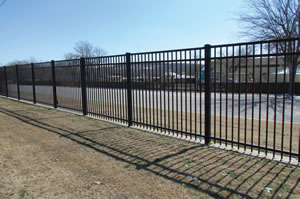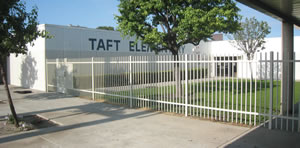Exterior Security Measures

PHOTOS COURTESY OF SCOTT BERMAN
Fences and related outdoor features are more than just a case of buy it and build it. Indeed, a number of K-12 schools have planned and implemented fencing systems strategically, as part of broader efforts not only to heighten security and safety, but also to do so in ways that meet the unique, changing needs of their campuses.
Take it from the outside in. For example, “most K-12 schools have a very definable boundary or real estate. It is imperative that the fencing declare those boundaries,” says Randy Atlas of Atlas Safety & Security Design, Inc. The key: That physical declaration, if you will, should be based on a policy declaration from within. As Atlas says, a school or district needs to “establish the ground rules on trespass, drug free zones”, and the like.
The right fencing solution requires a security culture that’s proactive and evolving to meet changing needs, according to Ameristar Fencing Products’ Barry Willingham, vice president, Security & Specified Products.
That being said, today’s fencing systems can typically cost anywhere from $20 to $120 per foot, Willingham points out. There are many variables, but essentially, “it depends on what you are trying to accomplish,” he says.
There is plenty to consider, for sure, when envisioning and implementing the right fencing system, and a number were described in a November 2013 study. Allyson Grennille, Hanover’s managing director, tells School Planning & Management that research indicates that factors widely include “stakeholder attitudes, budgetary constraints and aesthetics.” On that last point, she says, “a key takeaway in much of the literature is that schools should strive for a balance of security and aesthetics — particularly since a major argument against fencing tends to be that it creates an unpleasant or ‘prison-like’ environment for children.”
Districts need to navigate away from that situation and toward one that may require unique, customized aspects. As Grennille continues: “Experts tend to agree that there is no ‘one size fits all’ fencing material or fencing scheme. As such, districts should work toward a comprehensive plan that takes into account the unique environment and safety needs of individual campuses.”
There are various ways to go. In recent years, schools have implemented various fencing solutions to heighten security, define boundaries and channel traffic, such as Taft Elementary School in Santa Ana, Calif., and Loara High School in Anaheim, Calif., to take just two examples. In two other cases pointed out by Ameristar:
- Holland Hall, a private school, in Tulsa, Okla., phased in a five-year plan, starting in 2001, that included an aesthetically sensitive, eight-foot-high ornamental metal fence in front, chain link fences elsewhere, surveillance cameras, automated gates with off-hour keypad access, traffic control and an internal card security system, according to Willingham.
- Channel Islands High School in Oxnard, Calif., implemented a gate system that created four zones on its campus. The approach enables each zone to be opened or closed efficiently for access by students and the public as needed.

PHOTOS COURTESY OF SCOTT BERMAN
Careful Balance. The choice of fencing needs to be based on both security and aesthetics. While the fencing needs to be adequately durable and serve the role of heightening security, defining boundaries and channeling traffic, it needs to be aesthetically pleasing and not create a prison-like atmosphere.
As those schools’ efforts demonstrated, fences are a key part of a multi-pronged, multi-layered security platform, Willingham explains. Such a platform includes a robust fence that not only compartmentalizes a facility, but is also integrated with electronic security and notification systems, other physical components inside such as locks and hardened doors, and the training and protocols in place to make the entire array work swiftly.
Such systems, training and protocols speak to a safety culture, and establishing that culture heightens awareness of the risks and spurs changes in behavior. Have all that in place and a campus is significantly more secure, but it’s not a cure-all, says Willingham. “The point is to mitigate an event, not stop it,” he explains, comparing implementing such a system to locking a car door: Doing so greatly reduces risks — reduces, not eliminates. Thus, there is a need for the right perimeter security systems combined with other elements and continued vigilance.
Such matters and additional ones come into play as others seek and find their own solutions in diverse circumstances on campuses elsewhere. At one such campus, Robert E. Lee High School in Jacksonville, Fla., fencing and gates were installed as part of a major transformation of the school in recent years. There, the sets of fences and gates had to be designed to channel the public to and from the campus athletic field, students between the school’s main building and its gymnasium, and provide a service entrance to a new cafeteria building. And it does all that while maintaining an open feel for the busy campus and comporting well with the historic look of the renovated 1920s-vintage school.
With unique campuses come unique needs. Several organizations can help, and as Grennille points out, there’s “the National Clearinghouse for Educational Facilities and the National Crime Prevention Council. A handful of state departments of education, including those in Florida and California, have also published instructive information designed to guide districts as they consider school fencing.”
Finally, once the right fencing system is installed on a campus, it’s not just the end of a task. Instead, it could be considered as essentially one point in an ongoing, broader process. And that process requires vigilance as well as “persistence and maintenance commitments,” as Atlas adds, to keep the fencing in good working order and importantly contributing to campus safety, security and identity.
Some ideas about implementing fencing systems:
- Bear in mind that the right system may very well require some elements unique to your campus. Although fencing and outdoor features are manufactured in various materials, Lycra is not one of them. In other words, it’s not one size fits all.
- “Gather stakeholder feedback as part of the planning process,” suggests Hanover Research’s Allyson Grennille.
- Don’t let budget solely determine the outcome. Measure the expense against the impetus for, as mentioned, a heightened security package that includes a fence. If necessary for budgeting purposes, consider multi-year budgeting to phase in the right system for your facility, says Ameristar’s Barry Willingham.
For more information about Hanover Research’s study: “School Fencing: Benefits and Disadvantages”
This article originally appeared in the issue of .